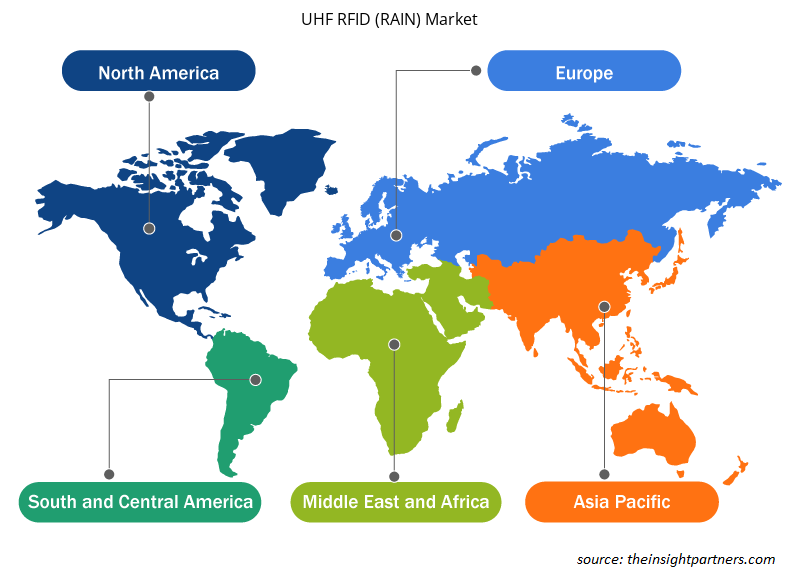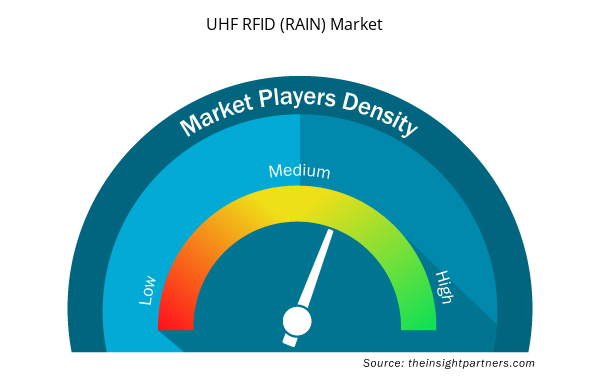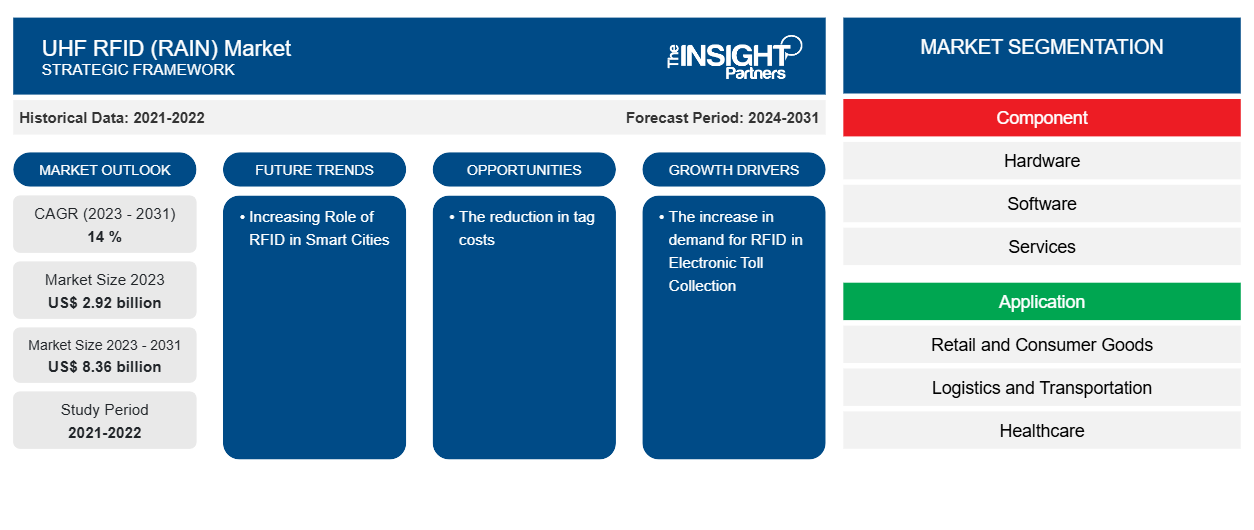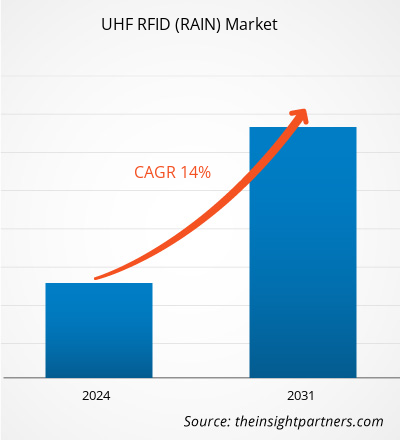UHF RFID(RAIN)市場規模は、2023年の29億2,000万米ドルから2031年には83億6,000万米ドルに達すると予測されています。市場は2023年から2031年にかけて14%のCAGRを記録すると予想されています。スマート シティにおける RFID の役割の増大は、UHF RFID (RAIN) 市場の重要なトレンドであり続けると思われます。
UHF RFID (RAIN) 市場分析
モノのインターネット (IoT) の台頭は、スマート デバイスの普及と、製造、公共事業、小売、その他の分野での研究開発と IoT 設備に集中する政府投資の増加によって推進されています。IoT は、さまざまなアイテムが相互に通信してデータを交換する機能を提供します。UHF RFID は、モノのインターネット アプリケーションに必要な、デジタル世界と物理世界を接続する最適なテクノロジです。ネットワーク化されたオブジェクトの大部分は、国境を越えてますます普及しつつあるパッシブ UHF RFID テクノロジのおかげでワイヤレスで接続されます。このテクノロジにより、パッシブ オブジェクトは正確な位置や時間などの重要なデータをスムーズに送信できるため、これらのオブジェクトの識別が可能になります。
UHF RFID (RAIN) 市場概要
UHF RFID システムは、UHF 周波数範囲を使用して動作する無線周波数識別 (RFID) システムです。超高周波 (UHF) 帯域の動作周波数は、300 MHz から 1 GHz の範囲です。無線周波数識別は、UHF RFID とクラウド間の接続を指す RAIN という単語の語源です。このテクノロジには、リーダーやタグなどの複数のハードウェア要素が組み込まれています。他のビジネスの中でも、小売、ヘルスケア、製造の各セクターでは、あらゆる種類の製品を追跡し、資産と在庫を管理するために RFID タグを利用しています。UHF RFID タグとリーダーは、433 MHz から 860 MHz で動作します。
要件に合わせてレポートをカスタマイズする
このレポートの一部、国レベルの分析、Excelデータパックなど、あらゆるレポートを無料でカスタマイズできます。また、スタートアップや大学向けのお得なオファーや割引もご利用いただけます。
- このレポートの主要な市場動向を入手してください。この無料サンプルには、市場動向から見積もりや予測に至るまでのデータ分析が含まれます。
UHF RFID (RAIN) 市場の推進要因と機会
電子料金収受におけるRFIDの需要増加
RFID 技術により、正確な車両識別が可能になり、それによって通行料金を差し引くことができます。REID システムのアーキテクチャは、自動車両識別とスムーズな通行料金控除プロセスを可能にするように注意深く設計されており、人間の介入の必要性を排除しています。電子料金徴収 (ETC) の分野は、REID 技術により革命を遂げ、道路、橋、トンネルの通行料金の支払いがスピードアップし、効率が向上し、通勤者や通行料金徴収業者にとってより快適になりました。ETC システムを使用する車両には、トランスポンダーと呼ばれることもある REID タグが装備されており、車両の所有者のアカウントにリンクされた個別の ID データを保持しています。RFID タグは、車両が料金所、ガントリー、または指定された入口/出口レーンに近づくと REID リーダーが生成する無線周波数信号によってアクティブになります。したがって、電子料金徴収における RFID の需要の増加に伴い、市場は成長しています。
タグコストの削減
モノのインターネット (IoT) は、業界の現在の急速な技術開発における主要な要因になると予測されています。多くの学者が IoT 技術に集中し、アーキテクチャと設計に関連する問題と課題を特定しています。市場の爆発的な成長の結果、IoT ソリューション プロバイダーの大半は、ハードウェア デバイスからクラウド サービスまで、すべてのスタック コンポーネントを構築しています。予測期間全体を通じて、IoT 技術の使用率が高いことが、UHF RFID (RAIN) 市場の成長をサポートすると予想されます。したがって、予測期間中、IoT の採用の増加により、UHF RFID (RAIN) 市場のプレーヤーに新しい機会がもたらされると予想されます。
UHF RFID (RAIN) 市場レポートのセグメンテーション分析
UHF RFID (RAIN) 市場分析の導出に貢献した主要なセグメントは、コンポーネントとアプリケーションです。
- コンポーネントに基づいて、UHF RFID(RAIN)市場はハードウェア、ソフトウェア、サービスに分類されます。ハードウェアセグメントは2023年に大きな市場シェアを占めました。
- アプリケーション別に見ると、市場は小売・消費財、物流・輸送、ヘルスケア、製造、その他のアプリケーションに分類されます。
UHF RFID (RAIN) の地域別市場シェア分析
UHF RFID (RAIN) 市場レポートの地理的範囲は、主に北米、アジア太平洋、ヨーロッパ、中東およびアフリカ、南米/中南米の 5 つの地域に分かれています。小売業界の活況により、北米の UHF RFID (RAIN) 市場は急速に拡大すると予想されています。この技術は衣類のタグ付けに広く使用されており、市場は近年急速に成長しています。860~960 MHZ 周波数帯域で動作するパッシブ UHF RFID タグは、通常、小売業界で使用されています。タグが機能する正確な周波数は、国によって異なります。
UHF RFID (RAIN) 市場の地域別分析
予測期間を通じて UHF RFID (RAIN) 市場に影響を与える地域的な傾向と要因は、Insight Partners のアナリストによって徹底的に説明されています。このセクションでは、北米、ヨーロッパ、アジア太平洋、中東およびアフリカ、南米および中米にわたる UHF RFID (RAIN) 市場のセグメントと地理についても説明します。

- UHF RFID(RAIN)市場の地域別データを入手
UHF RFID (RAIN) 市場レポートの範囲
| レポート属性 | 詳細 |
|---|---|
| 2023年の市場規模 | 29億2千万米ドル |
| 2031年までの市場規模 | 83.6億米ドル |
| 世界のCAGR(2023年~2031年) | 14 % |
| 履歴データ | 2021-2022 |
| 予測期間 | 2024-2031 |
| 対象セグメント | コンポーネント別
|
| 対象地域と国 | 北米
|
| 市場リーダーと主要企業プロフィール |
|
市場プレーヤーの密度:ビジネスダイナミクスへの影響を理解する
UHF RFID (RAIN) 市場は、消費者の嗜好の変化、技術の進歩、製品の利点に対する認識の高まりなどの要因により、エンドユーザーの需要が高まり、急速に成長しています。需要が高まるにつれて、企業は提供内容を拡大し、消費者のニーズを満たすために革新し、新たなトレンドを活用し、市場の成長をさらに促進しています。
市場プレーヤー密度とは、特定の市場または業界内で活動している企業または会社の分布を指します。これは、特定の市場スペースに、その規模または総市場価値と比較して、どれだけの競合相手 (市場プレーヤー) が存在するかを示します。
UHF RFID (RAIN) 市場で事業を展開している主要企業は次のとおりです。
- カーンRFD株式会社
- コンバージェンス・システムズ・リミテッド
- インピンジ株式会社
- インベンゴテクノロジー株式会社
- Jadak - Novanta 社
- ローリーソリューションズ株式会社
免責事項:上記の企業は、特定の順序でランク付けされていません。

- UHF RFID(RAIN)市場のトップキープレーヤーの概要を入手
UHF RFID (RAIN) 市場のニュースと最近の動向
UHF RFID (RAIN) 市場は、主要な企業出版物、協会データ、データベースを含む一次調査および二次調査後の定性的および定量的データを収集することによって評価されます。以下は、音声および言語障害の市場における動向と戦略のリストです。
- 2023 年 11 月、超高周波 (UHF) 無線周波数識別 (RFID) の開発と採用を支援する非営利業界団体である RAIN Alliance は、RAIN RFID タイヤ テクノロジー マスタークラス ワールド ツアーの開始を発表しました。四半期ごとに開催されるこれらのマスタークラス イベントでは、世界のインテリジェント タイヤ業界の将来について独自の視点を提供するとともに、RAIN RFID が、誕生から廃棄までのタイヤの製品ライフサイクル全体を追跡するという課題の解決にどのように役立つかを探ります。(出典: RAIN Alliance、プレス リリース)
- 2023 年 10 月、HID は新しい LinTRAK RAIN RFID UHF タグを市場に投入しました。(出典: HID、プレスリリース)
UHF RFID (RAIN) 市場レポートの対象範囲と成果物
「UHF RFID(RAIN)市場規模と予測(2021〜2031年)」レポートでは、以下の分野をカバーする市場の詳細な分析を提供しています。
- 対象範囲に含まれるすべての主要市場セグメントの世界、地域、国レベルでの市場規模と予測
- 市場の動向(推進要因、制約、主要な機会など)
- 今後の主な動向
- 詳細なPEST/ポーターの5つの力とSWOT分析
- 主要な市場動向、主要プレーヤー、規制、最近の市場動向を網羅した世界および地域の市場分析
- 市場集中、ヒートマップ分析、主要プレーヤー、最近の動向を網羅した業界の状況と競争分析
- 詳細な企業プロフィール
- 過去2年間の分析、基準年、CAGRによる予測(7年間)
- PEST分析とSWOT分析
- 市場規模価値/数量 - 世界、地域、国
- 業界と競争環境
- Excel データセット



Report Coverage
Revenue forecast, Company Analysis, Industry landscape, Growth factors, and Trends

Segment Covered
This text is related
to segments covered.

Regional Scope
North America, Europe, Asia Pacific, Middle East & Africa, South & Central America

Country Scope
This text is related
to country scope.
よくある質問
The global UHF RFID (RAIN) market was estimated to be US$ 2.92 billion in 2023 and is expected to grow at a CAGR of 14 % during the forecast period 2023 - 2031.
The increase in demand for RFID in Electronic Toll Collection and the reduction in tag costs are the major factors that propel the global UHF RFID (RAIN) market.
The increasing role of RFID in smart cities is anticipated to play a significant role in the global UHF RFID (RAIN) market in the coming years.
The key players holding majority shares in the global UHF RFID (RAIN) market are CAEN RFD Srl, Convergence Systems Limited, Impinj Inc., Invengo Technology Pte. Ltd., and Jadak- A Novanta Company.
The global UHF RFID (RAIN) market is expected to reach US$ 8.36 billion by 2031.
Trends and growth analysis reports related to Electronics and Semiconductor : READ MORE..
The Insight Partners performs research in 4 major stages: Data Collection & Secondary Research, Primary Research, Data Analysis and Data Triangulation & Final Review.
- Data Collection and Secondary Research:
As a market research and consulting firm operating from a decade, we have published and advised several client across the globe. First step for any study will start with an assessment of currently available data and insights from existing reports. Further, historical and current market information is collected from Investor Presentations, Annual Reports, SEC Filings, etc., and other information related to company’s performance and market positioning are gathered from Paid Databases (Factiva, Hoovers, and Reuters) and various other publications available in public domain.
Several associations trade associates, technical forums, institutes, societies and organization are accessed to gain technical as well as market related insights through their publications such as research papers, blogs and press releases related to the studies are referred to get cues about the market. Further, white papers, journals, magazines, and other news articles published in last 3 years are scrutinized and analyzed to understand the current market trends.
- Primary Research:
The primarily interview analysis comprise of data obtained from industry participants interview and answers to survey questions gathered by in-house primary team.
For primary research, interviews are conducted with industry experts/CEOs/Marketing Managers/VPs/Subject Matter Experts from both demand and supply side to get a 360-degree view of the market. The primary team conducts several interviews based on the complexity of the markets to understand the various market trends and dynamics which makes research more credible and precise.
A typical research interview fulfils the following functions:
- Provides first-hand information on the market size, market trends, growth trends, competitive landscape, and outlook
- Validates and strengthens in-house secondary research findings
- Develops the analysis team’s expertise and market understanding
Primary research involves email interactions and telephone interviews for each market, category, segment, and sub-segment across geographies. The participants who typically take part in such a process include, but are not limited to:
- Industry participants: VPs, business development managers, market intelligence managers and national sales managers
- Outside experts: Valuation experts, research analysts and key opinion leaders specializing in the electronics and semiconductor industry.
Below is the breakup of our primary respondents by company, designation, and region:

Once we receive the confirmation from primary research sources or primary respondents, we finalize the base year market estimation and forecast the data as per the macroeconomic and microeconomic factors assessed during data collection.
- Data Analysis:
Once data is validated through both secondary as well as primary respondents, we finalize the market estimations by hypothesis formulation and factor analysis at regional and country level.
- Macro-Economic Factor Analysis:
We analyse macroeconomic indicators such the gross domestic product (GDP), increase in the demand for goods and services across industries, technological advancement, regional economic growth, governmental policies, the influence of COVID-19, PEST analysis, and other aspects. This analysis aids in setting benchmarks for various nations/regions and approximating market splits. Additionally, the general trend of the aforementioned components aid in determining the market's development possibilities.
- Country Level Data:
Various factors that are especially aligned to the country are taken into account to determine the market size for a certain area and country, including the presence of vendors, such as headquarters and offices, the country's GDP, demand patterns, and industry growth. To comprehend the market dynamics for the nation, a number of growth variables, inhibitors, application areas, and current market trends are researched. The aforementioned elements aid in determining the country's overall market's growth potential.
- Company Profile:
The “Table of Contents” is formulated by listing and analyzing more than 25 - 30 companies operating in the market ecosystem across geographies. However, we profile only 10 companies as a standard practice in our syndicate reports. These 10 companies comprise leading, emerging, and regional players. Nonetheless, our analysis is not restricted to the 10 listed companies, we also analyze other companies present in the market to develop a holistic view and understand the prevailing trends. The “Company Profiles” section in the report covers key facts, business description, products & services, financial information, SWOT analysis, and key developments. The financial information presented is extracted from the annual reports and official documents of the publicly listed companies. Upon collecting the information for the sections of respective companies, we verify them via various primary sources and then compile the data in respective company profiles. The company level information helps us in deriving the base number as well as in forecasting the market size.
- Developing Base Number:
Aggregation of sales statistics (2020-2022) and macro-economic factor, and other secondary and primary research insights are utilized to arrive at base number and related market shares for 2022. The data gaps are identified in this step and relevant market data is analyzed, collected from paid primary interviews or databases. On finalizing the base year market size, forecasts are developed on the basis of macro-economic, industry and market growth factors and company level analysis.
- Data Triangulation and Final Review:
The market findings and base year market size calculations are validated from supply as well as demand side. Demand side validations are based on macro-economic factor analysis and benchmarks for respective regions and countries. In case of supply side validations, revenues of major companies are estimated (in case not available) based on industry benchmark, approximate number of employees, product portfolio, and primary interviews revenues are gathered. Further revenue from target product/service segment is assessed to avoid overshooting of market statistics. In case of heavy deviations between supply and demand side values, all thes steps are repeated to achieve synchronization.
We follow an iterative model, wherein we share our research findings with Subject Matter Experts (SME’s) and Key Opinion Leaders (KOLs) until consensus view of the market is not formulated – this model negates any drastic deviation in the opinions of experts. Only validated and universally acceptable research findings are quoted in our reports.
We have important check points that we use to validate our research findings – which we call – data triangulation, where we validate the information, we generate from secondary sources with primary interviews and then we re-validate with our internal data bases and Subject matter experts. This comprehensive model enables us to deliver high quality, reliable data in shortest possible time.


 このレポートの無料サンプルを入手する
このレポートの無料サンプルを入手する